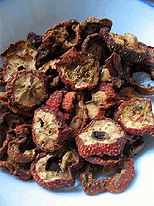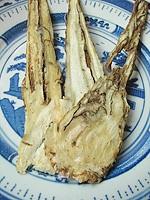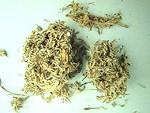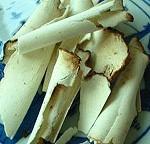According to traditional Chinese medicine (TCM) theory, a localized symptom often reflects stagnated flow of blood and qi of the whole body, the meridian system has disturbed. Weight loss management should not focus on diet alone, regulating the whole body functioning is also important. Treatment based on syndrome differentiation is the TCM method for weight loss, in other words, physicians will first evaluate the condition of each person, and then design an individualized plan to help them suppressing appetite, increasing metabolism and burning fat. Obese people are divided into different disharmony patterns, and so their treatments vary.
1. Harmonizing stomach to dissolve fat 
Most obese people like to eat greasy and sweet food, which tend to cause food detention in the stomach and digestive difficulties, leading to bloating in the gastric and abdominal regions, belch, acid reflux, bad breath and a greasy tongue coating. Herbs such as hawthorn fruit, wheatgerm and radish seed are commonly used to regulate stomach functions, promote digestive secretions, and aid fat and grease decompositions.
2. Activating blood and removing stasis 
Too much fat in the blood tends to cause hardening of blood vessels, which is one of the phenomena of blood stasis in Chinese medicine. Physician will then aim to activate blood and remove stasis to promote blood flowing, lower blood lipids and slow down the hardening of blood vessels. Common herbs for these purposes include angelica root, Sichuan lovage rhizome, red sage root, red peony root and notoginseng.
3. Soothing chest and resolving phlegm 
Excess fat inside the body is interpreted as phlegm accumulation in Chinese medicine, which can lead to signs like breath shortness, chest oppression, dizziness and glossy and greasy tongue coating. When further developed into severe accumulation of phlegm and fire, the obese people will present agitated, impatient, high blood pressure, distending headache, insomnia, hard stools, yellow and greasy tongue coating. Herbs such as Mongolian snakegourd fruit, Mongolian snakegourd seed, longstamen onion bulb, immature bitter orange, submature bitter orange, and tangerine peel are commonly selected to regulate and unblock the water channels in the lungs and resolve the turbid phlegm.
4. Soothing liver and promoting bile flow 
In TCM, liver is responsible for regulating qi movements and promoting transformation and transportation of spleen and stomach. The bile juice helps the digestion of fat. Common herbs for these purposes include oriental wormwood, zedoray rhizome, turmeric rhizome and cassia seed. The herbs are also effective for liver and gallbladder problems such as fatty liver or gallbladder stones.
5. Inducing urination and draining dampness 
In TCM, pathological products such as dampness and phlegm are all attributed to dysfunctional fluid metabolism. Dampness is a mist form of fluid immersed in body tissues, and phlegm is a condensed form of retained fluid. Obese people often have disorder in fluid metabolism, leading turbid-phlegm and retained fluid evolved from the body fluids, and blood lipids increased. Inducing urination and draining dampness can enhance redistribution of the body fluids, and discharge excess water out of the body directly. Common herbs used for the purposes include waxgourd peel, oriental water-plantain rhizome, poria and plantain seed.
6. Purgation 
Obese people tend to accumulate excess metabolic wastes and undigested food inside the body, constipation is common among them. Laxatives promote bowel movements and accelerates the metabolic products to excrete, and thus prevent further accumulation of fat tissues inside the body. Commonly used herbs include Chinese rhubarb, giant knotweed rhizome, senna leaf, and fleeceflower root.
In general, the above six methods are aimed at expelling pathogens inside the body, which helps the body relieve metabolic accumulations such as excess fluids, dampness, phlegm or stasis. In practice, physicians often apply them in combination rather than one method only. When obese people also accompanied with other deficient states, such as weakened in particular organs or certain chronic problems, then methods like invigorating spleen or kidney are necessary. As supporting the healthy energy can facilitate the expelling of pathogens.







